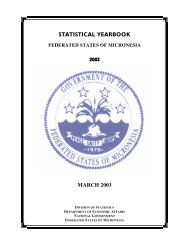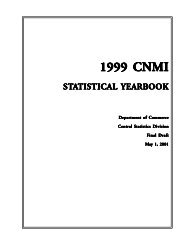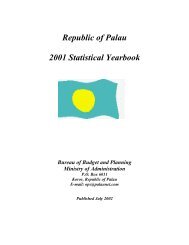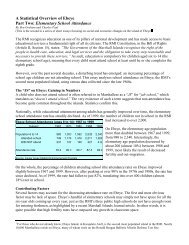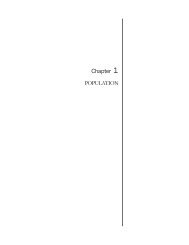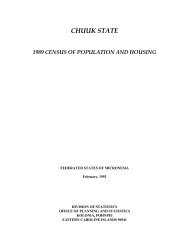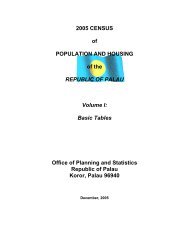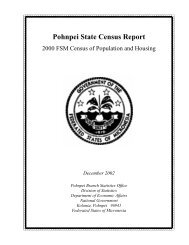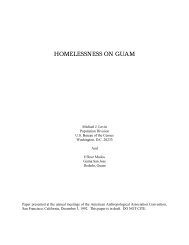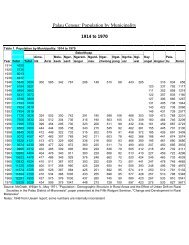Chuuk State Census Report - pacificweb.org
Chuuk State Census Report - pacificweb.org
Chuuk State Census Report - pacificweb.org
You also want an ePaper? Increase the reach of your titles
YUMPU automatically turns print PDFs into web optimized ePapers that Google loves.
CHAPTER 7RELIGION, ETHNICITY AND LANGUAGEIntroductionThe questionnaire used in the 2000 <strong>Census</strong> contained several questions on social characteristics of the population suchas religion, ethnic origin and language. In <strong>Chuuk</strong>, religion-related <strong>org</strong>anizations, like youth programs, play animportant role in the community, making data on religion necessary for planning purposes. The data provided in thischapter show two major religious affiliations: Catholic and Protestant. Under Protestant there are several sects withCongregational being the largest group. The Protestant religion first came to Micronesia in 1852, beginning work onPohnpei and Kosrae, and soon afterwards expanding to <strong>Chuuk</strong>. Although the mission sending <strong>org</strong>anization wasinterdenominational, most of the missionaries represented the Congregational Church (Hezel, 1983). The data onreligion tell us about people’s religious affiliation.Data on ethnicity is useful in planning processes and social research. Ethnic origin tells about where a person'sancestors came from. The 2000 <strong>Census</strong> data showed majority of the <strong>Chuuk</strong> residents were of <strong>Chuuk</strong> origin. Thelargest foreign (non-local) ethnic group in <strong>Chuuk</strong> in 1994 was the Asians, which included mostly Filipinos andChinese. The Chinese population has decreased in 2000 from 1994 due to the expiration of the fishing companycontract to <strong>Chuuk</strong> <strong>State</strong> in the intercensal period. The second largest non-local ethnic group was the Whites. Thisgroup included persons from Europe, U.S., Australia, and New Zealand.The data on language use provide information for bilingual programs in school, and at the work place. In the history of<strong>Chuuk</strong>, different second languages were taught in schools depending on the administering country. During the JapaneseAdministration (from 1914 to 1945), Japanese was used as the common language in schools, offices, and other places.When the U.S took over at the end of the World War II, English became the main language for communication. Atpresent, English is the medium of official communication at the government offices and even in the private sector.DefinitionsReligionThe 2000 <strong>Census</strong> obtained data on Religion from responses to questionnaire item 7, asked of all persons regardless ofage and sex. For census purposes, religion was defined as a religious or spiritual belief or preference, regardless ofwhether or not this belief was represented by an <strong>org</strong>anized group.EthnicityItem 6 on the 2000 <strong>Census</strong> questionnaire concerned ethnicity or race. The question relied on self-identification andwas open-ended. Ethnic origin or race refers to a person's origin or descent, including an individual's heritage or theplace of birth of an individual's ancestors. Persons reported their ethnic group regardless of the number of generationsremoved from their place of ancestral origin. Responses to the ethnic origin question reflected the ethnic group withwhich persons identified and not necessarily the degree of attachment or association the persons have with a particulargroup.Most respondents reported their ethnic origin or race by specifying a single ethnic group, but some reported two orthree groups. <strong>Census</strong> staff identified and coded the first two responses reported.In published tabulations, the 2000 <strong>Census</strong> designed multiple groups as general open-ended categories and such as"<strong>Chuuk</strong>ese and other group(s) "rather than specific multiple ethnic groups such as <strong>Chuuk</strong>ese-Japanese." Thus, the censuswould include a person who reported "<strong>Chuuk</strong>ese” and “Filipino" ethnicities he will be tabulated in the "<strong>Chuuk</strong>ese andother group(s)" category under "Multiple ethnic group". The 1994 and 2000 <strong>Census</strong>es accepted "American" as a uniqueethnicity if given alone or with the state names.LanguageThe language questions (15a and 15b) were asked only of persons 5 years old and over and obtained two items: whatlanguage(s) does one speak and what language does one speak at home. For persons who spoke more than 3 languages,only the three most common were listed. For language spoken at home, only the one mostly used is recorded.<strong>Chuuk</strong> Branch Statistics Office, Division of Statistics, FSM Department of Economic Affairs 57



